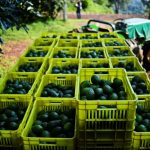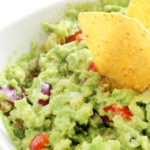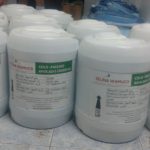
Packed avocados [Getty Images]
Brief Background
In a world of plenty, avocados come in variety and there are about a dozen such cultivars of this fruit. However, Hass together with Fuerte are the two main types. Some countries like New Zealand produce Hass worth 90 percent of the total production levels. In Kenya, Fuerte constitutes 80 percent of the total output. Hass, on its part, as the main export provides 20 percent of the total output. This essentially makes the two as the main sources of revenue for the table avocado exports from Kenya. In 2017, the dry fruits constituted 46.7MT of overseas’ sales without counting by-products. Guacamole is one of such by-products worth a look.
Guacamole
 Nearly all stories surrounding the by-products of avocados consider guacamole, a mash meal that originated in Mexico. In Kenya, this meal has become both a home and away success as it has attracted creative ways of preparation.
Nearly all stories surrounding the by-products of avocados consider guacamole, a mash meal that originated in Mexico. In Kenya, this meal has become both a home and away success as it has attracted creative ways of preparation.
The most straightforward way is that of using at least half a dozen avocados and pounding them into a paste. For the best results, guacamole avocados should be just soft but not overripe. Other ingredients include garlic whose mincing goes hand-in-hand with a halved lemon and a diced small tomato.
After pitting the fruit and cutting it into slices, professional cooks of guacamole in Nairobi then mix all the content of the garlic/coriander/lime merger into the wholesome fruit paste. After pounding them into viscous mash, then it is time to add the tomatoes and onions on top together with salt. The mixture then goes into a cooler for half an hour before it is ready to serve.
The best serving meal with guacamole is yet another dish from Mexico, the enchiladas which is buttered chicken. In Kenya the equivalent is the baked restaurant chicken. Talking about chicken, next is a look at a frying aid in the name of avocado oil.
Enriched Virgin Avocado Oil
 For the health-conscious, nothing goes badly with a sauce made of avocado oil which consists of 75% unsaturated fat. Indeed, avocado oil has added stamina in the way it is produced, under low temperature cold pressing. This leads to a rich way of enjoying the pure fatty acids straight from the cradle. The fruit’s pulp has about 30 percent in oil content in terms of weight. The seed, on the other hand, has less than 2 percent while the skin consists of 7 percent.
For the health-conscious, nothing goes badly with a sauce made of avocado oil which consists of 75% unsaturated fat. Indeed, avocado oil has added stamina in the way it is produced, under low temperature cold pressing. This leads to a rich way of enjoying the pure fatty acids straight from the cradle. The fruit’s pulp has about 30 percent in oil content in terms of weight. The seed, on the other hand, has less than 2 percent while the skin consists of 7 percent.
For those in search of avocado oil as vegetable fat, it is true that the oil retains the gist of the pulp’s ingredients. These include the up to 24 percent of lipids that help maintain bodily metabolism against metabolic diseases like diabetes. There is also up to 78 percent of moisture, which goes to 65 percent after drying. The other retained content is 3 percent of dietary fiber from the fruit’s dry weight. Indeed, all the ingredients that make the avocado to have several times greater health value than all other fruits with the exception of the nutrient-loaded banana, are all retained in the oil.
The Hass avocado from countries like Kenya, Mexico, New Zealand and Guatemala, among other sub-tropical regions produces extra virgin avocado oil with a difference in culinary purposes. Its relatively good smoke point of over 250° Celsius has been attributed with great frying. Indeed, at its purest, the oil has the distinctive green avocado color which may come from the great levels of carotenoids.
In terms of value addition, the fat from the avocado needs separation from the water content. For instance in the production of cosmetics, a principle initial step is the removal of water to less than 65 percent. The next step involves the extraction of the seed and the epidermis.
Immediately, the skinned and pitted fruit goes into a malaxing machine where it is heated for at most 1 hour at less than 50° Celsius. There are some quarters who contest that this is not cold-pressing. However, the heat is essential to melt out much of the deeply-entrenched oil in the pulp without compromising on its quality.
The crude product then goes through a centrifugal system with the aid of a lemon solvent for separating oil from water. This leads to the settling of oil on top which is then led to a decanter. The pulp and lees of the final product then serve as soil enrichment for other avocado trees.
How about the extra-nutrients of the avocado? By nature, extra-nutrients are phytonutrients which unlike common components like starch, protein and vitamins, have active abilities over diseases. Some of the potent ones in the avocado are sterols. Findings in the original home of the fruit, Mexico, have shown that people who take the fruit regularly reduce their bad cholesterol by 17 percent levels. Indeed, the secret lies in the phytosterol, which is a component that imitates the appearance of cholesterol and inhibits it.
Here is a look at other functional uses of the inedible parts of the avocado.
Enriched Avocado Peels as Tea and Animal Feed
Another by-product of the Kenya avocado is its peels. Actually, 40 percent of the livestock herders’ budgets especially in zero grazing go to food supplements. With avocado peel with its rich composition of 7% oil, minerals and other acids, it is possible to cut much of the feed costs. Research has shown that the peels have become a part and parcel of commercially available feed.
Outside the livestock sector, the avocado peel is also a tea extract. Yes, indeed, before stowing away that outer skin, you might as well know it is a potential antioxidant. Studies in Latin America have shown that the fruit’s epidermis has phenolics that fight free radicles and these are accessible as tea additives.
The extraction of the avocado peel tea requires a dry skin. It first goes through artificial dehydration to remove any remaining moisture. It then features in a methanol-solvent extraction process before purification.
Compared with other fruits whose skins serve as tea sources, such as the apple, studies on avocado have shown very potent activity against free radicals. This is because their extra-nutrients like flavonoids are higher than those of their substitutes like apples. The flavonoids refers to a set of components in many plants that prevent diseases like diabetes due to their bioactive nature.
Traditionally, the avocado peel has gone into mulch-making. It provides rich mineral formation together with the ingredients such as pulp that have just undergone processing. They are therefore a good source of soil enrichment.
Avocado Pulp
The freshest naked content of the average avocado is the pulp. It consists both moisture and oil as well as the fat that makes the rich creamy yellow flesh highly nutritious. Though the production of the pulp is just as easy as peeling, cutting and slicing, it also undergoes mechanical extraction for enrichment.
The process involves machine peeling, pitting and then slicing of the pulp into equal or symmetrical parts. These then go into air-tight cans under vacuum for conservation. They are common to find in salad shops or groceries all over the world.
The pulp consists of 70 percent of the avocado’s main weight with the rest going to the pit. The main ingredients of the pulp, being a wholesome product, include oleic acid which is a major monounsaturated fat of the fruit. Its role is to boost immunity. The fruit’s pulp also constitutes virtually all fiber at 2.72 grams out of each 100 grams of the fruit. The biggest content is fat 1t 17.34 grams while carbohydrates follow at 6.94 grams with proteins trailing at 2.1 grams. They also have lutein at 248 milligrams per 100 grams. Lutein is reportedly a source of carotenoid, which helps in eye health improvement.
Now that one has got pulp, oil and raw Kenya avocados, where can on sell them?
Potential and Existing Markets for Kenya Avocado By-products
Other than dry avocados, Kenya has plenty of markets where its virgin avocado oil and other by-products go into export. Refined oil and fruit pulp are some other exports. These are supplemented by crude avocado which contains fibers and pulp without sieving like the rest.
Key traditional markets for the products for Kenya include France with a share of 39 percent of the market while the US despite producing its own, imports 10 percent. Belgium accounts for 6.5 percent of the sales while the other parts of the world led by Japan, the Middle-East and Western Europe account for the other portion.
In terms of the actual use of all shipments, the two major world markets that aggregate avocados from all over the world consume a combined 1 million tons of the fruit yearly. Seven hundred and fifty thousand tons go into use in the US alone, while the EU and UK consume two hundred and ninety thousand tons of the fruit yearly. These are just the figures of 2013, which means that the consumption capacity has risen since then.
New markets in Asia have not caught on well with by-products but currently import raw avocados from Kenya. By 2018, the list had including the entire Malay Peninsula, Korea, and China. The latter county is the most potential of all markets mainly due to population, and renewed interest in unsaturated healthy fat from the avocado. In 2016, China’s avocado trade had gone up by a hundred and twenty seven times in comparison with the 2014 figures. In the latter year, 4 million kilograms of the fruit were eaten in China.
Israel, Southern Europe (particularly Spain) and South Africa have been the main rivals for Kenya. This is despite the fact that Kenya has slightly larger Hass cultivars than its tip of Africa neighbor (24.0z versus 18 oz. per avocado). Therefore, in a case of avocado oil production, each Kenya avocado has a higher capacity than its South African counterpart. In 2017 there were negotiations to improve the sale of avocados and related products from Kenya to South Africa after a ban that had persisted for several years.
The local market which accounts for 80 percent of Kenya’s avocado sector is also a source for by-products. In the soap category, the locals go for mixed natural products including avocado oil and coconut oil that produce natural detergents. There is also a craze for lotions with drops of this fruit, which helps introduce the skin-nourishing oleic and linoleic acids. These acids have richer skin permeation abilities in comparison with synthetic oil ingredients that are just skin deep.
To ensure that the products meet quality standards and market specifications, the Kenya avocado sector has a number of regulatory authorities as seen below.
Quality Bodies
For the avocado and its by-products to pass the market test, it goes through several bodies for quality check up. The two main ones in Kenya are Kenya Plant Health Inspectorate Services (KePHIS) and the Fresh Produce Exporters Association of Kenya (FPEAK). The first one is directly responsible for the tracking of residual levels and other phytosanitary measures in the raw fruit. The exporters body, on its part, ensures that its export fruit is of high quality for the country.
There are also agricultural bodies for the fruit that connect family growers to the international market. These provide stipulations to cooperatives which they deal with on the specific size, grade and quality of the fruits at harvest time. For instance, the Avocado Growers Association of Kenya (AGAK) oversees that all its interconnected growers’ SACCOs meet the export measures through farm visits.
Conclusion
Therefore, the life of the avocado fruit is enhanced by the many by-products it has courtesy of value addition. While the fruit’s pulp is a major source of oil, the peel and the seed serve as nutritious animal feed when they are not doubling as mulch. The same applies to the value added commercial products such as soap which enjoy the rich make up of the fruit.
References
http://www.fao.org/3/a-au996e.pdf
http://www.scielo.br/pdf/cr/v46n4/1678-4596-cr-46-04-00747.pdf
https://www.standardmedia.co.ke/business/article/2001275146/avocado-exports-grow-to-sh6-5b
https://www.nation.co.ke/lifestyle/living/Off-to-the-Land-of-Samba-with-enchiladas-guacamole-and-sangria/1218-2788512-323n2/index.html
sokodirectory.com/2018/02/kenya-among-top-avocado-exporters-world
https://www.avohass.com/images/Quality_mannual.pdf
https://www.researchgate.net/publication/293042011_Use_of_avocado_peel_Persea_americana_in_tea_formulation_A_functional_product_containing_phenolic_compounds_with_antioxidant_activity
http://ir-library.ku.ac.ke/bitstream/handle/123456789/13806/animal%20feed%20suppliment.pdf?sequence=1&isAllowed=y
http://www.scielo.br/pdf/cta/v32n2/aop_4900.pdf
http://botholtd.com/wp-content/uploads/2016/10/Avocado-manufacturing-potential-in-Kenya.pdf

